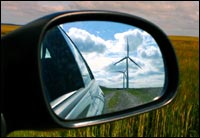Dear Umbra,
In your response about opposition to wind farms, you neglected in your enthusiasm to say how much electricity from wind would actually be used and what effect, if any, the farms would have on our overall energy use. Can you cite an example of actual reduction of fossil- and nuclear-fuel use brought about by existing wind farms on a general grid? And if so, couldn’t conservation bring even more benefits, without “adding modestly” to the industrial depredations of yet more roads, power plants, transformers, and transmission lines?
Eric Rosenbloom
Kirby, Vt.
Dearest Eric,
Watch out, this answer is filled with numbers and metaphors.

Let’s give wind power another look.
Global energy demand is on the rise. The only path toward a sane future is to work simultaneously on conservation and renewable-resource development. Wind offers us a road toward sustainable energy and economic generation — especially in developing countries and in rural areas of developed countries.
In 2003, the U.S. generated 3.883 trillion kilowatt-hours of electricity. All non-hydro renewable sources combined — wind, biomass, solar, etc. — contributed about 2 percent of that supply. Wind turbines have generating capacities that range from 200 watts to 2 megawatts; by the end of 2004, the U.S. had 6,470 MW of wind capacity, and is expected to generate almost 18 billion kilowatt-hours in 2005. That’s about 0.5 percent of our annual electric generation.
Some think wind could provide 20 percent of our electric supply; others claim that North Dakota alone has enough capacity to power a third of American households. But right now, as we can see, wind is a drop in the bucket, a balloon in a gale, a metaphor-rich tiny bit of our energy supply. I checked with the American Wind Energy Association to see whether they could regale us with tales of wind replacing nuclear power, and the like. That’s difficult, and here’s why. Right now, traditional fossil fuels and nuke plants are like your trusted day-care center: they have steady hours of operation and have proven they can take care of your “kidowatts.” Whereas wind is like the younger sister you call to take the kids when you have to work late: a great gap-filler. Sometimes she’s flaky (i.e., when the wind doesn’t blow), but as she gets older (i.e., as technologies and weather prediction improve), she’s more and more reliable. And someday, she might even work at the day care.
Returning from metaphor-land, I do have some promising news from AWEA: there are many examples of wind beating the old standbys when it comes to new bids for energy generation. Take the town of Lamar, Colo. When local activists forced their energy supplier to consider wind during the bidding process, natural gas was blown away. Wind was a clear winner on economic points, and will save area consumers $4.6 million in power bills in one year. Wind has also been smacking down natural gas during bidding in the Eastern U.S., according to the region’s electricity transmission organization, PJM.
Wind’s ace in the hole is that it is free. Technological development makes the case for renewables stronger, and conservation makes the load lighter. If capacity and technology improve steadily (or, in the case of wind, exponentially) while we take every opportunity to conserve and to shun coal and nukes, the arguments against renewables will weaken. And we will win.
Triumphantly,
Umbra

